
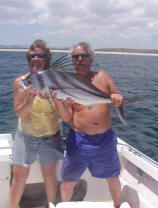
 |
Mexican Fishing Adventure in The Sea of Cortez |
 |
The 3rd week of May 2007, 16 persons, that was coordinated thru an advertisement in The Reel News, made a fishing adventure to the Sea of Cortez between Cabo San Lucas and La Paz Mexico off the southern tip the Baja peninsula. These were mostly Puget Sound Anglers or friends who may well soon become members. The air flight took most of us from Seattle (some from Portland) to Cabo San Lucas, then a little over an hours drive north thru pretty desolate countryside north to a resort called Hotel Punta Colorada. This fishing resort dates back to the days of the Hollywood stars like Bing Crosby etc.
| Welcome sign at the gate | Photo from the patio dining area toward some of the newer rooms |
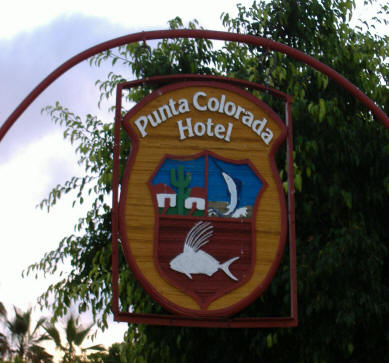 |
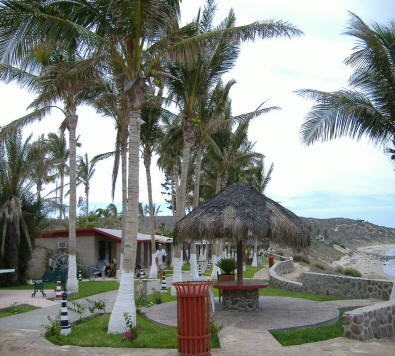 |
This Resort : This fishing resort is a well oiled machine that caters to fisherpersons and offers 23' Super Pangas up to 35' +- Cruisers for the boat people. It caters not only to the boat fisherpersons, but kayak and or fly fisherpersons as well. You will see fly fishing from the beach, or paddling a kayak even a few spinning outfit casters from the beach also. They also have 4 wheel drive Honda quads to rent for these beach fisherpersons, which allows a greater access to these fine beaches. The rooms are clean, maid service is every day. One thing you will encounter is that you are not issued a key for your room. This resort has a rock wall pretty much around all of it with an entrance gate with a sign overhead as shown above and anyone other than guests would be readily recognized.
Buildings here all seem
to be made of concrete blocks with tile roofs. Air conditioning is in
every room, water apparently is from a spring. The beds were harder than
we were accustomed to, but surprisingly were quite comfortable. There were
many tall palm trees around the resort. There even was a section of
newly worked ground with young palm trees growing, which apparently was for replanting of some of
the few that had died or damaged from hurricanes, or for future use. A
grounds man watered the palm trees frequently. Well maintained green grass was
between the sidewalks where there was no slate.
On the slate patio are a few thatched roofed shelters made of palm leaves that
have a nylon type net covering. This covering is apparently for wind
protection of the leaves. Our skipper told us that these roofs can last
for up to 15 years unless ruined by a hurricane. Flowers are
everywhere.
There are 2 wide stone walkways from the patio down to the beach where there are usually 3 or 4 saddle horses available for rent by an enterprising young businessman.
Occasionally there were peddlers who approached from the seaward side selling tee shirts, or jewelry. The word was that they can not come onto the patio, but can hawk their wares from outside the low stone patio retainer walls. A word of caution, do not pay the initial asking price. Our group one night was jerking a peddlers chain. He offered a flexible sea shell / silver fish about 12" long and passed it around for our inspection. This fish was well made and could be bent in arc shapes within reason, even to where it could be stood on it's bent tail, initially for $140 US, the roundtable negotiations soon got him down to $100. Another member said $50, of course the peddler declined. But when it was apparent that no one was really interested, the peddler finally came back to the person who made the $50 offer, only to be told no, not tonight.
To order refreshments from the bar simply ask to have it added to your bill using your room number. There is a gift shop in the office area. However prices are not reasonable, as a cap with their name on it sells for $18 US. They will accept MC or VISA on checkout.
| The greeting sign put up for our group |
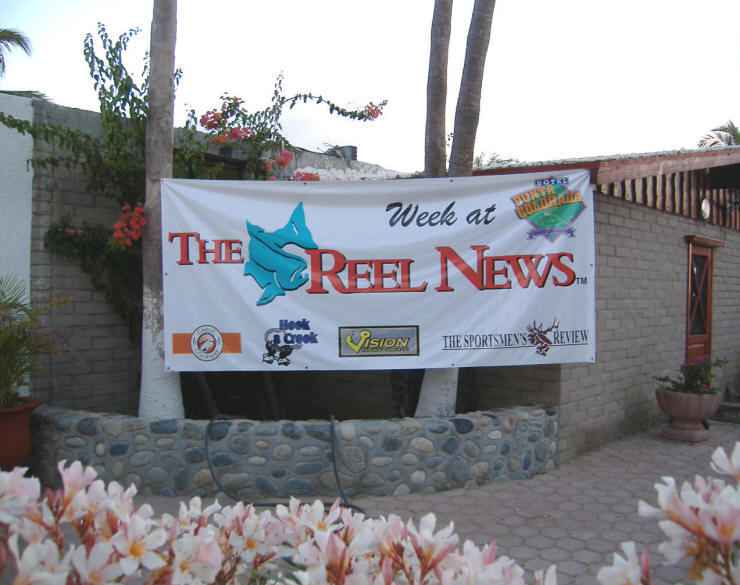 |
This resort is known as the Roosterfish capitol of the world.
| Punta Colorada fishing resort from the water |
 |
Boats 1 :
The pangas are usually
limited to fishing up to 20 miles offshore toward the east into the Sea of
Cortez, where the cruisers may venture out to 40 miles chasing Marlin, Dorado
or Yellowfin Tuna. At times the pangas will encounter these fish also
depending on the water or other conditions. The pangas typically
will concentrate closer to shore for Roosterfish, Jack Crevell, Red Snapper, Triggerfish,
Grouper or
Pompano. These super pangas usually are powered by outboard motors
ranging from 125 to 200hp. I never saw a trolling motor on any of
the boats, as all the trolling was done at a relatively fast speed in
comparison to our salmon trolling.
The Pangas are
usually owned by the individual skippers who contract with the resort.
Someone said that a Panga is usually an 18' boat while the super Pangas are 23
to 25'. These fiberglass boats are usually about a foot narrower
than boats made in the US of comparable size. I
will have to say that all that we were on and saw there were very well maintained.
There were only a couple of newer units, but the older boats were well cared
for. Our skipper had carburetor problems at the end of the first day and
opted to take it in for repair the following day. He was back the 3rd
day as he had promised, said that one carburetor had picked up some small
debris in the jetting, even though he had an extra automotive inline filter in place.
Their refueling is by gas cans on the beach at night.
| A typical 23-24' Super Panga |
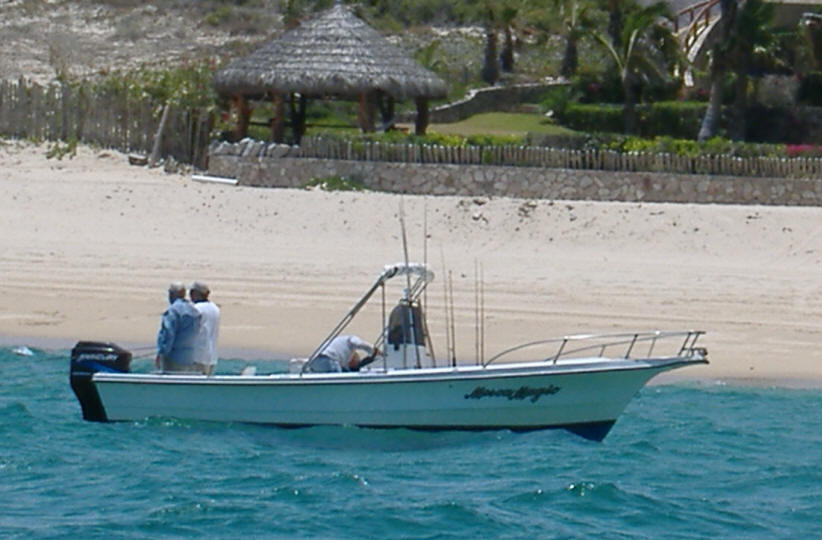 |
You Start the
Fishing Trip the Afternoon of the Day Before :
You usually will fly in the day before
then
get settled in. In the afternoon about 6 PM the "Fish Master" will arrive.
It is best to be there early, as you need to meet
with him to get your boat assignments and very likely if you are late the better
skippers are already assigned. It is with him that you make your selection
of the type of lunch, whether you want water or beer for the next
days outing. All references are back to your room number. This
older Mexican gentleman was a great guy who speaks English well. Dinner is at 7:30
PM. Usually the dinner is either served on the outdoor patio or by a
serving line depending on the meal.
All the
eating for the guests was outdoor on the patio. The
food is very good.
Preparations :
You need to take sun-blocker in at least a SPF 30 or higher. Sunscreen even in a SPF of 30
proved not effective, I don't know the difference, but Jerry's friend used sunscreen
but
got burned. You really need some sort of a hat to protect your ears along
with the
back of the neck where the fishing bill type caps with an attached rear neck cover
as seen off the Florida Keys fishing are very effective for this. Long sleeve
shirts are preferred for us Gringos who do not get exposed to the sun that much.
About everyone wore short pants, with the most seen were the ones with the zippered
removable legs. Sandals with no socks have their place here also, even going
barefoot on the boats is common.
A Word About
Seasickness :
Of our group none
of us encountered this dreaded disease. The water here is calm enough but
not a lot of tidal movement that it was about like being on Puget Sound on
a good day with no wind. My wife gets seasick quite frequently on
the ocean. Here she talked to our doctor beforehand, got a patch, but
never used it and she felt fine every day we fished.
Starting Your Day : We got up at 5:30 AM and breakfast is served inside the dining room cafeteria style at 6 AM. Inside this dining area is a pool table, on the upper walls are mounted fish of many species. Most everyone ate inside for breakfast as the sun was usually just coming up so the temperature had not risen yet.
There usually was no wind in the morning so the water was quite calm most all mornings. If the wind picked up at all, it would be about 1PM and would come from the south when we were there.
You need to be at the dock
near 7:00 AM with all of your gear, if you took any,
(which most of us did) for the shallower water fishing anyway. They have a
small school bus as transportation to the dock, however most of us just walked
the 500 yards or so down the sandy road.
The dock is a portable
dock on wheels that is placed in position on the beach with the tongue at near a
medium tide level. You may have to wade to it if the tide is in or time your
movement with the waves. At
the dock in the morning, everyone lines up with their rod, reels and usually a
backpack of personal items or tackle. Just offshore is the fleet of
Cruisers anchored. At about 6:30 AM a small, (16') outboard skiff transfers
skippers and deckhands out to the cruisers and life livens up. Many Pangas will
arrive by water just after daybreak from the next little village of La Ribera about 6 miles north.
The Fish Master somehow coordinates which boat moves in to pick up his passengers for the day. He will call out your room number, then you proceed to the end of the dock and board your assigned boat, which can at times be a long jump (depending on the tide, as the dock is stationary) but this feat is performed with the aid of the skipper along with helping hands on the dock.
Your skipper will then proceed out to a nearby bait skiff to purchase live bait that goes into the live-wells in all the boats. It is your responsibility to pay for this bait. The amount was USUALLY $20 US. However one bit of advise here, is do not offer only a $20 bill, but say (2) $10 bills instead, as one day the bait guy gave me back $10 when we did not have many left
| Bait boat transferring bait to a cruiser | Ed's hogfish |
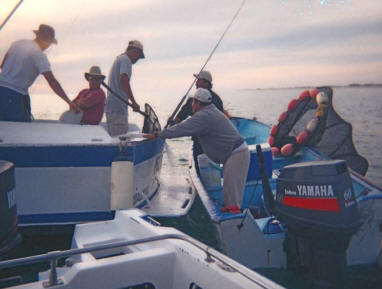 |
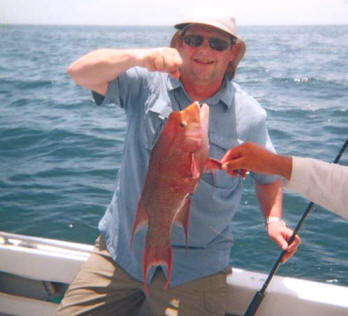 |
Another bit of advise
is let your skipper know before the bait purchase which type of fish you want to
pursue, as it may well make a difference as to the size and quantity of bait he orders.
It seems that most of the fisherpersons who come here want to fish for Marlin,
Tuna, Dorado etc. which are usually deeper water fish. So these skippers
will usually tend to think this is what you may also want, and if you are like most of us you do know understand much of their language. The
wife and I lucked out in that our Panga skipper spoke very good English with
whom we
shared many friendly conversations every day we were on his boat.
As in any experience to
a foreign country, it may be best to try to learn a little of their language, as
it seems here that they think IF you are assigned to a cruiser, you want to fish
for Marlin or Dorago out farther from shore, while normally a Panga skipper will
think you want to fish for Roosterfish close to shore. You are
putting a cruiser skipper and his deckhand into a totally different environment,
(and also possibly out of their elements as far as knowledge) if you ask them to
fish for the shallow water fish.
All the
boats had heavier rods and tackle for the Marlin , Dorado, and Tuna fishing, but no
lighter salmon sized gear for the smaller fish. So from the bait
boat, you are
off to the fishing area for the day or until about 2 PM. The Pangas will
normally fish closer to shore, (sometimes within slingshot distance) early in
the mornings. However we did catch fish later in the day there also, so
the fish may also write their timetables here as elsewhere.
Along shore is some rock structure, but mostly underwater with not many that are exposed much beyond the beach. The sand is rather course and a whitish cream color. The inshore water is a pretty light blue, so when you are over rocky bottom, the rocks do not appear to protrude much more than a few feet above the bottom. The white sand fills the gaps between the rocks, so you have a black/white patchy bottom as viewed from the surface. As you go deeper the water color changes to a slightly deeper blue color and way out yet another deeper blue.
Don't think that all the fishing is from boats, as at times if Roosterfish herd baitfish against the beach, casting jigs into the small surf can be exiting.
This resort also caters to fly fishers, utilizing rental quads for exploring the vast sandy beaches.
Most all of the boats have a compass, but of all of us there, none observed a sonar unit, however we did not have access to the upper deck of the cruisers to verify this. One skipper was said to have had a hand-held GPS unit. It appears that they fish here like we did in the states 50 years ago before the intrusion of electronic equipment, by simply knowing about where they have traditionally caught fish and simply repeat the process daily. But most of the Pangas are beached each night, so having to deal with a sonar sender on the stern might not even be worth it.
Some of the Pangas may anchor out with the cruisers at night. it is suspected these may be owned by the resort. However most are privately owned by the skipper that lives in the little town just north of the resort. Our skipper was one of these and he told us that he pulls his boat out each afternoon with a large rope attached to the front of his 4 wheel drive pickup. Once on the beach way above high tide, he can then do any repairs and refuel it. He pays a nominal "beach fee" for the right to park it there. In the morning, he then turns the boat around and pushes it from the stern back into the water with the pickup. At the resort's dock area, they use a large front-end loader to pull the resort owned Pangas ashore when needed. There appears to be one community boat trailer for the cruisers that the loader also hooks onto and pulls it out for maintenance.
| Beaching a Panga with the front-end loader, a cruiser already there for prop maintenance, with the school bus to provide transportation back to the resort & the pickup that was used to transport all the ice coolers to the dock in the morning. The portable dock's shore end just showing in the lower photo. |
 |
Tackle ;
Most of us on this trip took our own
lighter tackle. Light tackle like steelhead gear may well prove just a tad
on the light side as these fish seem to fight a lot harder than steelhead do.
A medium salmon rod from 7' to 8' 6"with a line rating of 10-20# proved adequate
for me. A medium reel in the size of Shimano TR-200 or the Tekota
TEC400 or 600 and I found the line counter version proved effective in knowing how far
out to run the bait, which was usually about 90'. I loaded my level-wind reels with 40# Power Pro. The spinning reel was a Shimano
Sedona 6000 loaded with 25# monofilament Ande line. I had another spool of 15#, but
after seeing how these fish fight, I never used it.
Our trolling outfits
for the shallow water fish was a Shakespeare 7' Ugly Stick 2 piece 10-20# rated
rod and a Cabellas Depth Master II DM-20 which has a line counter.
My spinning rod was a Shakespeare 7' Ugly Stick 2 piece 12-25# (which was
heavier than I really wanted, but all that was available in a 7' 2 piece rod).
This rod had a VERY large rear guide that I removed, then moved the rear tip
section guide to the butt section and
added a intermediate guide where the 2nd one was. Initially this rod's
rear guide was so large it would not allow me to get it in the rod case. These
casting outfits proved a great combination in that when using live bait here it was
hooked thru the upper lip, then just trolled letting them swim behind the boat
or casting lead-head jigs. Also the length was about right if on the pangas to be able to maneuver around with the convertible top up.
With this Power Pro line when trolling, I could feel every movement of the 5 to 12" live bait. You could even at times anticipate a bite in that if the bait got very active, it could well have been for a reason. You say why 12" bait for a 24" fish, well the bait boats may only have caught that size the night before. The only problem is that when using this size of bait it was not uncommon to have a fish on for a couple of minutes only to loose it because it simply let go of the bait and was not hooked. Matter of fact once the wife had a roosterfish on for about this amount of time, got it near the boat only to have the fish spit the bait out, when recovered, the bait was still alive with no visible loss of skin so it was put back into the water for another go around.
For many of this type of fishing they let the un-weighted line and the live bait out behind the boat from 70 to 90' then troll fast enough to keep the bait just under the surface of the water. The reel's clutch engage lever is left out with just your thumb on the spool. When a fish takes the bait, let it free-spool for 25-30' before you set the hook.
| Roosterfish just before being boated | Nancy's first Roosterfish & the same one in the photo on the left which was 24" |
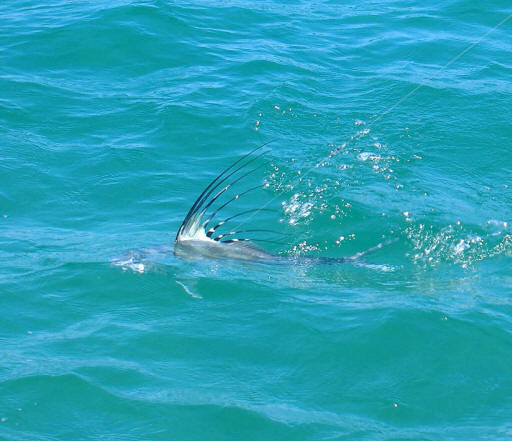 |
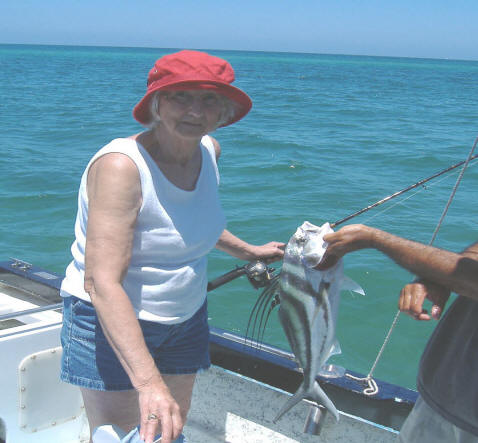 |
| A 24" 6# Pompano | Paul with a 20# Bull Dorado |
 |
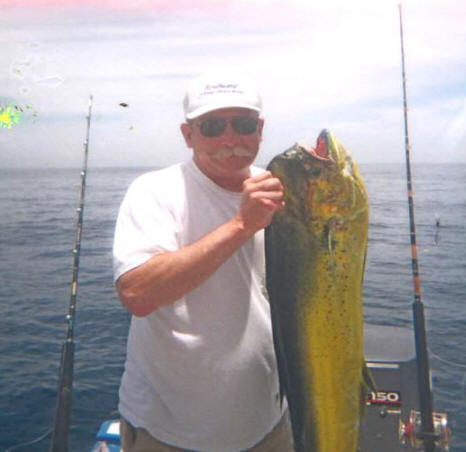 |
It is not uncommon to
catch Roosterfish 24" long and weighing in at 5# or so, even larger. While there, we saw
one from the resort's patio late in the evening that was feeding on baitfish on
the surface and within 100' of the shore, that had to be at least 40" long.
Some of the fishing was
done drifting over rocky bottoms using chunks of cut up baitfish.
I tried casting with a spinning outfit, using a lead jig similar to a Point
Wilson Dart that the skipper supplied and also with my 1 ounce bulletnose leadhead jig with a curlytail
attached, but did not have a strike, but neither did the wife using bait. I wish
I had more time to try the leadhead jigs as they have proved very efficient for
Washington coastal black rockfish and ling cod.
Boats 2 :
The cruisers appear to be
from 30' to about 35' in length. All have an upper skippers deck or
flying bridge and a hard or cloth top for the fisherpersons. These all
appear to be diesel powered, with refueling in the afternoon using a LONG gravity
hose from a large diesel fuel tank far up on the shore. They are
anchored at night offshore a few hundred yards near the dock area.
As mentioned previously, in the morning a
small, (16') outboard powered skiff transports the skippers and deckhands out to
their boats.
A day on the cruiser will start also by picking up bait from the bait boat anchored nearby. These are called cruisers by the resort, but I do not know the actual Mexican definition, but they are normally used for fishing out in deeper water and will chase the Marlin, Tuna, or Dorado. Most all of their rods are heavy roller guided 6' standup tuna rods. I never saw a lighter salmon type outfit on the cruiser we were on.
The cruiser we were on was a fast boat, had a large cushion over the engine cover. It had 2 fighting chairs, however both appeared to have been abused by many fishermen in the past as the pedestals were loose at the seat, which allowed the seat to wobble, which then made it hard to simply sit in this chair. When fighting a fish they may have been better.
This deck-hand spoke very little English and I believe that he misunderstood when I initially told him that I wanted to fish for shallow water fish but was not interested in roosterfish as we had caught them the day before. Maybe he thought we wanted roosterfish. We did fish shallow water for about an hour with no action, then I took stock of all the heavy gear, I decided that maybe I was placing them in a situation whereby they were not accustomed to.
So when I suggested we go farther out for marlin, they had no problem understanding this request. And it did give us the opportunity to experience deep water fishing in the Sea of Cortez. When trolling for marlin or dorado here, they ran 3 rods off the stern, 2 off the side outrigger poles, with one off the center of the upper deck near the skipper which allowed that lure to go way back on the rest. It got rather boring trolling around for 4 hours with no activity. The skipper never came off the flying bridge and the deck-hand retreated there soon after he set the gear out or pulled them in and changed to a different colored popper.
| Trolling for marlin aboard a cruiser with Nancy waiting | Ed's 8'+ - 145# marlin caught off a Panga |
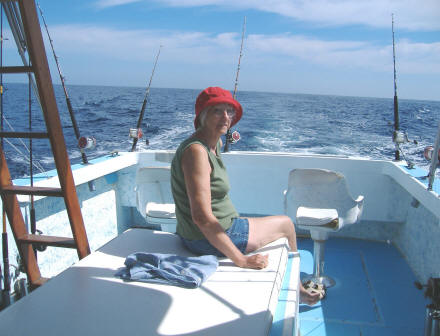 |
 |
Pre-Trip
Readiness :
It is suggested that you
travel light. Many of us took a 50 quart ice cooler that had wheels on the
rear with a tall handle on the front. This was intended for bringing
home any frozen fish that we caught. It also served as a place to put the baggage bag
in on the flight there. When traveling with this cooler type of baggage, the lid
needs to be secured either by duct tape, bungee cords or a ratchet type strap.
I also carried a small roll of duct tape in my backpack, just in case.
Also identify your baggage with some sort of color indicator, as a bright strap,
flagging tape or something to make yours identifiable from the many other
"black" bags and almost identical coolers.
You now need a passport when moving around the airports, it and your boarding passes need to be readily available. I just kept mine in a large shirt pocket, but with that warm weather, sweat would have taken a toll if it remained there for long. I did see a few travelers with a special passport pouch around their neck in which they carried all these important papers in, which seems a better way to go.
As for clothing, a lightweight nylon long sleeved fishing shirt and nylon pants that have zip off legs was most commonly seen. I took a change of shorts for each day plus a couple of Tee shirts other than the clothes that I flew in with. One afternoon my wife washed my fishing shirt in the bathroom sink and hung it up there where there was no air conditioner. It was dry by the next morning. A fishing bill type cap with an attached rear neck cover as seen off the Florida Keys is a good investment. Sandals have their place here. Between the two of us, she took one small carry on bag and another bag that could have been carried on, but was placed inside the cooler during transportation. Medication was placed in a separate plastic Ziploc bag in my backpack.
I took a backpack for my reels, some terminal tackle as jigs, curly tails, swivels, snaps etc. My rod case was simply a 3" PVC (next time it will be a 4") tube with the end caps and screw in plug on the other end. It had a 3/8" nylon rope handle that allowed me to sling it over my shoulder with the top behind me with the lower end near the floor. Our checked baggage was the rod case and the cooler. Carry on was her small day bag and my backpack. I took a cheap imitation of a Leatherman tool that was packed in the checked baggage going down, but left it in the room with a $10 tip for the maid when we left.
As for cash to take with you, there is no need to convert to Mexican pesos as they are very happy with US dollars and seem to price most everything accordingly. I suggest you take more $5 and $10, then some $20, with possibly a few $50's. The smaller bills work great for tips and you will in all probability not get a refund on a $20 bill for a tip when a $10 would have sufficed. We took about $350 cash each but spent only about 1/2 of that.
Learn the peso to US
dollar exchange rate before you go. Or get an app for your phone
that converts currency. I did notice at the food counter
at the airport in Cabo that the prices on the counter were all in pesos, but
when we paid for the food, it seemed that the exchange rate seemed to get about
doubled for us gingos as we paid considerably higher. After getting home
and
looking up on the internet, the exchange rate, the 110 total pesco price he
established for our meal, he however asked for $22 US, in reality it should have been $10.20.
In all probability he pocketed the difference, as no receipt was given. If so, the perks
for this job were very good.
Our Panga
skipper told us
that most of the fishermen they get there are from Washington, Oregon,
California or Alaska, with a sprinkling of Canadians.
Observations :
My suggestion is to try to
learn at least some Spanish, as it is rather hard to communicate, or to go away
not being sure that you really got across to them what you wanted.
One young man who worked the check-out, doing the billing on computer and
accepting credit cards seemed to get along well, but when I talked to him later
(or tried to) it was quite obvious that he was about as bad at English as I was
with Spanish. Most of the help at the resort could understand a sprinkling of English, as if
you told something funny to another fisherman, you may get a chuckle out of the
Mexican nearby. Or like one time when one of the Pangas was close to
shore and one fisherman mentioned to the other something about pretty girls
walking on the beach. The skipper seemed to understand enough that
he then also used binoculars for a closer look.
After catching your fish, if it is left on the boat, then I am sure that the skipper makes a meal of it for his family. When Ed Lindsey caught an 8' marlin of about 145# and was going to release it has he had caught others in his previous life in California. When the skipper realized Ed was intending to release it, he quickly said it was hooked deep and would die, then before Ed could say anything, bonked it. He then asked if he could have it, as it would feed 10 families. Ed said sure.
If you want to bring
home some of your fish, it is my suggestion to have the skipper fillet the fish
soon after catching it (or you ask if you can do it), put the meat in the ice
of the cooler that was placed onboard when you boarded the boat that morning. The meat surely
would be better than laying in a very warm fish box for hours in 90 degree
temperature. When you get back to the dock, tell the dock attendant your
room number and that you want the fish inside your cooler frozen so you want to take
it home.
Depending on who
fillets the fish, one Pompano that I caught late in the day, near shore and from
the cruiser, the deckhand did not offer to fillet it, so I placed it in the
cooler (by bending it's tail) and had the resort fillet it out, (well kind of
sort of). Not much meat was retained for the size of the fish as
compared to what we got off of the same sized roosterfish.
On your return trip to the airport, about 1/2 hour before you are scheduled for your taxi van to leave, go to the office, have them get your fish from their freezer and put it in your cooler. We brought back 5 vacuum packed and frozen fish packages, with the price for this being $7 US, of which I just gave him a $10 bill.
Travel to and from the airport in the vans or taxis as they called them, we all tipped the driver $5 per person. Bartenders were usually tipped a $1 or $2 depending on the totals.
| The resort's Mexican mascot, never in a hurry & can sleep anywhere | Sunrise as viewed off the resort's patio |
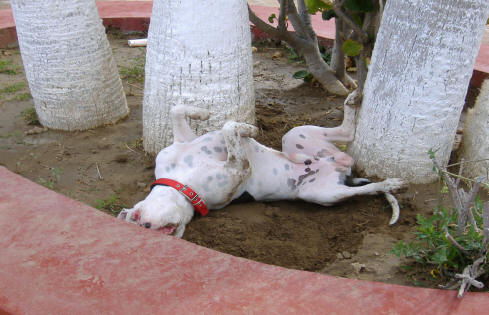 |
|
Copyright © 2007 - 2023 LeeRoy Wisner All Rights Reserved
Back to the Main Ramblings Page
Originated
05-19-2007 Last updated 02-01-2023
Contact the author